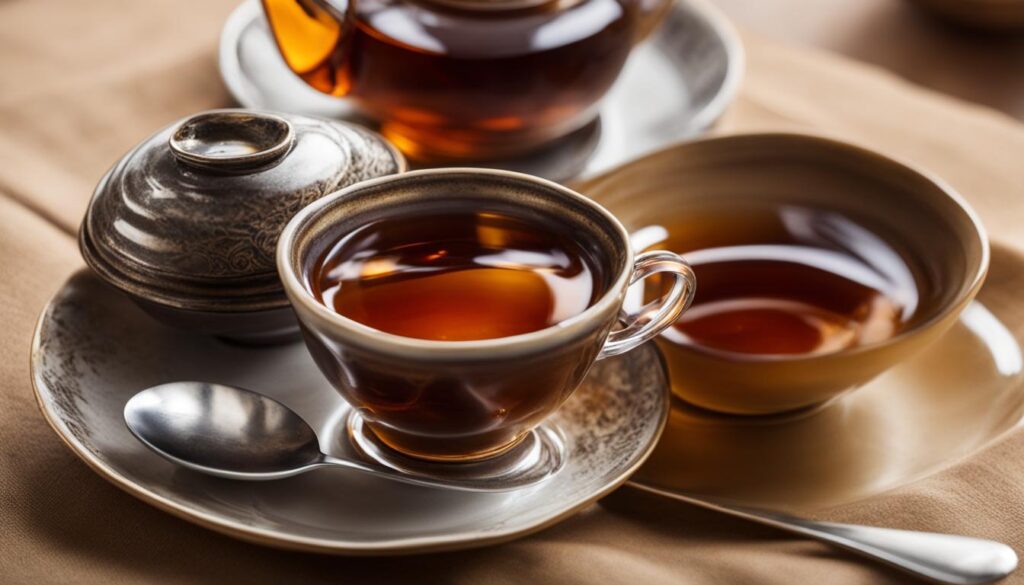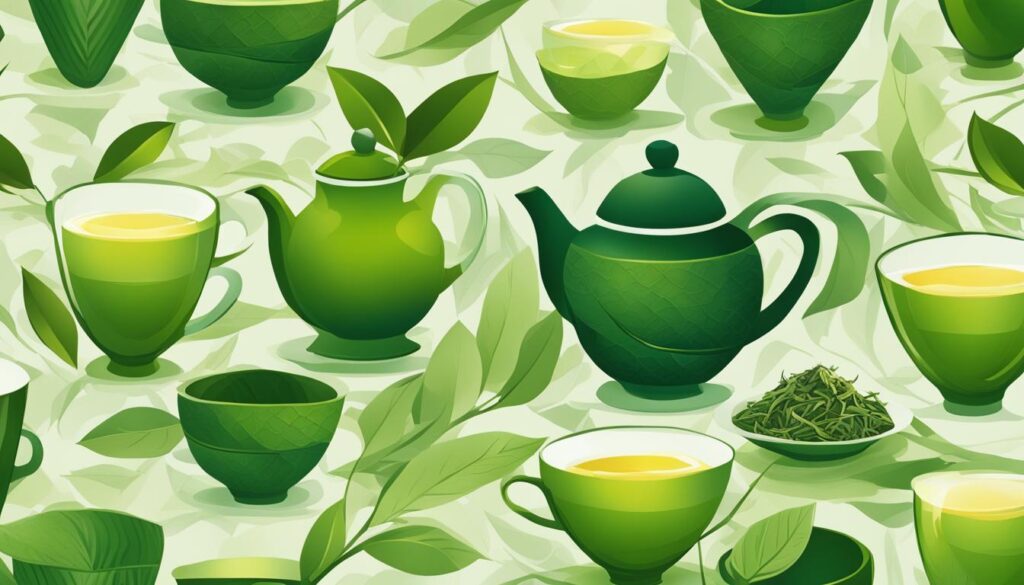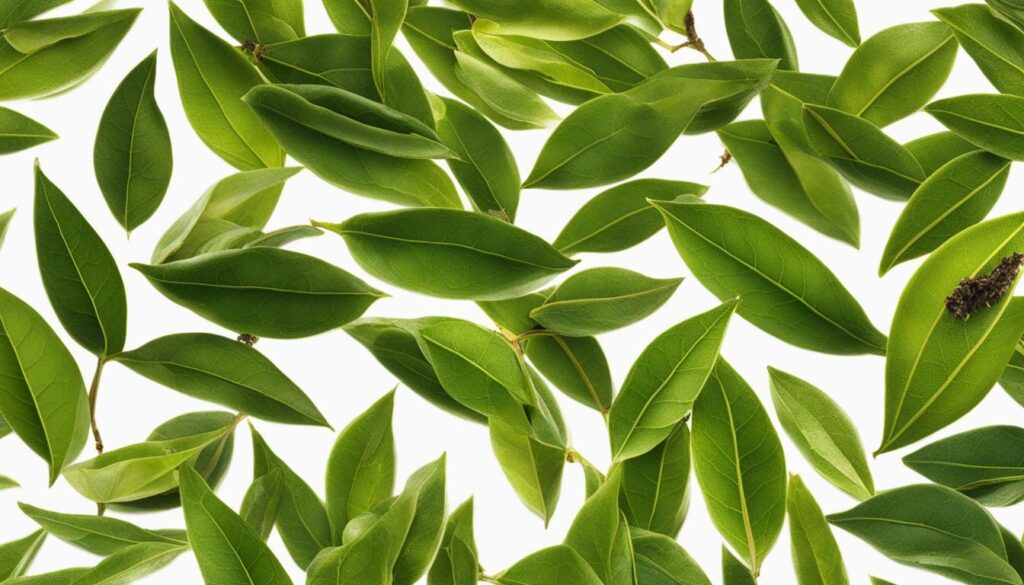
We’ve Got a Taste for Tea: Techniques for Detecting Defects through Tasting
Tea, oh tea, the beloved beverage that warms our hearts and soothes our souls. Whether sipped in solitude or shared with friends, the quality of tea is of utmost importance to both consumers and producers. We know that taste is a subjective experience, but there are techniques that can help us detect defects in tea and elevate our enjoyment of this ancient elixir.
At the heart of tea defect detection lie the artful techniques of tasting. By diving deep into the world of cupping tea, evaluating its characteristics, and identifying common defects, we uncover the secrets that lie within each delicate leaf. It’s a journey that takes us on a sensory adventure, guided by our palates and a desire for the perfect brew.
Key Takeaways
- Tea defect detection is essential for maintaining tea quality.
- Techniques such as cupping tea and evaluating its characteristics can help identify defects.
- Understanding the role of tea tasters and using evaluation tools and methods is crucial.
- ISO standards provide guidelines for consistent tea evaluation.
- Improving tea quality enhances the satisfaction of tea consumers.
The Tea Cupping Procedure
When it comes to evaluating the quality of tea and identifying defects, the tea cupping procedure is an essential technique. Cupping tea allows us to assess its characteristics and detect any imperfections. So, let’s delve into the tea cupping process and explore how it helps us in evaluating tea.
To begin, we use a standard 3-piece ceramic cupping set for brewing the tea. This set includes a cup in the shape of a bowl, a cup with a handle, and a lid. These specific tools ensure consistency in the preparation and evaluation of tea samples. It’s important to note that using the same type of vessel for all samples allows for accurate comparisons.
Next, we follow specific ratios of tea to water, water temperature, and steeping time. A strong brew is crucial for identifying defects and evaluating the tea’s aroma, appearance, and liquor. By paying attention to these characteristics, we gain insights into the quality of the tea.
The tea cupping procedure is a fascinating journey into the world of tea flavors, fragrances, and nuances. It allows us to distinguish between different varieties, assess their strengths and weaknesses, and identify any defects that may impact the overall experience.
By following the tea cupping procedure, we can effectively evaluate the characteristics of the tea and identify any defects present. This knowledge helps us make informed decisions about the quality of the tea and enables growers and processors to improve their products.
| Tea Cupping Procedure | Benefits |
|---|---|
| Use a standard 3-piece ceramic cupping set | Ensures consistency in sample preparation |
| Brew tea with specific ratios of tea to water, temperature, and steeping time | Allows for accurate evaluation of tea characteristics |
| Evaluate aroma, appearance, and liquor of the tea | Provides insights into the quality of the tea |
The tea cupping procedure is a valuable tool for tea enthusiasts, growers, and processors to assess the quality of tea and detect any defects. It allows us to appreciate the intricate flavors and aromas that make each tea unique, while also ensuring that only the finest teas reach the market.

Evaluating Tea Characteristics
When cupping tea, we pay attention to its aroma, appearance, and liquor. These characteristics provide important insights into the overall quality of the tea:
- Aroma: The fragrance of the dry leaves, wet leaves, and liquor can vary greatly. We look for pleasant, inviting aromas that are characteristic of the tea variety.
- Appearance: The appearance of the dry and wet leaves can indicate the level of processing and the quality of the tea. We examine the color, size, and uniformity of the leaves.
- Liquor: The color and clarity of the brewed tea, known as the liquor, can reveal a lot about its quality. We observe its hue, brightness, and transparency.
By carefully evaluating these characteristics, we can gain a deeper understanding of the tea and appreciate its unique qualities. Whether it’s the floral notes of a delicate green tea or the rich earthiness of a pu-erh, the tea cupping procedure allows us to explore the world of tea with our senses.
Characteristics of Green Tea
When evaluating green tea, it is important to understand its general characteristics. By closely examining the appearance, density, feel, and aroma of the dry leaves, wet leaves, and liquor, we can gain valuable insights into the quality of the tea.

Appearance
The appearance of green tea leaves can vary depending on factors such as the harvest time and processing methods. High-quality green tea leaves are usually plump, well-shaped, and vibrant in color, while lower-quality leaves may appear dull or have irregular shapes. The consistency and uniformity of the leaves are indicators of the tea’s quality.
Density
The density of green tea leaves can also provide insights into its quality. When examining the dry leaves, high-quality tea will feel dense and heavy, indicating that it contains a higher concentration of essential oils and nutrients. Lower-quality leaves may feel lighter and less dense.
Feel
The feel of green tea leaves can be evaluated by gently rubbing them between your fingers. High-quality leaves will feel smooth and supple, while lower-quality leaves may feel rough or brittle. The texture and resilience of the leaves can give clues about their freshness and processing methods.
Aroma
The aroma of green tea is one of its most distinctive characteristics. By smelling the dry leaves, wet leaves, and the brewed liquor, we can assess the quality and complexity of the tea. High-quality green tea will have a fresh, vegetal aroma, with subtle notes of grass or flowers. Lower-quality tea may have a stale or unpleasant aroma.
Understanding these general characteristics of green tea can help us evaluate its overall quality and make informed decisions when selecting and enjoying this beloved beverage.
Common Defects in Green Tea Production
Tea production is a delicate process that requires careful attention to detail. However, despite the best efforts of growers and processors, certain defects can occur during the production and processing of green tea. These defects can impact the flavor, appearance, and overall quality of the tea. Understanding the common defects in green tea production is essential for tea producers to identify and address these issues effectively.
There are several causes of defects in green tea production. Improperly harvested tea, for example, can result in leaves that are too old or damaged, leading to a subpar final product. Similarly, improperly withered tea can affect the flavor and aroma of the tea. Adequate and consistent heat during fixation is crucial for achieving the desired taste profile, and any deviations in heat can result in defects. Improper rolling and drying techniques can also contribute to defects in the final product.
To provide a comprehensive understanding of common defects in green tea production, here is a table showcasing the most prevalent defects, their causes, and their impact on the tea:
| Defect | Cause | Impact |
|---|---|---|
| Brown Tea | Excessive heat during fixation | Loss of delicate flavor and aroma |
| Yellow Tea | Inadequate heat during fixation | Muted flavor and lack of complexity |
| Black Tea | Improper rolling and drying | Bitter taste and dark color |
| Musty Tea | Improperly withered leaves | Funky smell and unpleasant taste |
By familiarizing themselves with these common defects and their causes, tea producers can take proactive measures to prevent and minimize their occurrence. This knowledge helps in maintaining the quality and consistency of green tea, ensuring a delightful tea-drinking experience for consumers.

Sources:
- Green Tea Quality Evaluation: Identifying Common Defects
The Role of Tea Tasters
Tea tasters are the unsung heroes of the tea industry, using their exceptional sensory skills to evaluate and analyze the quality of tea samples. They play a vital role in ensuring that only the finest teas make it to market, and their expertise is invaluable in maintaining the reputation of tea brands and cultivators. Tea tasters undergo rigorous training to develop their palates and sense of smell, allowing them to identify the subtle nuances and characteristics that differentiate exceptional teas from mediocre ones.
In addition to their tasting skills, tea tasters possess a wealth of knowledge about tea cultivation, processing techniques, and regional variations. This allows them to provide valuable insights to tea producers and processors, helping them to improve their methods and create teas that meet the demands of discerning consumers. Tea tasters also play a pivotal role in blending different teas to create unique flavor profiles, ensuring that each batch of tea meets the desired taste and aroma requirements.
Tea tasters are an integral part of the tea industry, ensuring that the teas we enjoy are of the highest quality. Their dedication and expertise contribute to the success of tea brands and the satisfaction of tea enthusiasts around the world.
The Skills of Tea Tasters
- Exceptional tasting abilities, with a well-trained palate and sense of smell
- Extensive knowledge of tea cultivation, processing techniques, and regional variations
- Understanding of the characteristics that differentiate high-quality teas from lower-quality ones
- Ability to analyze and evaluate hundreds of tea samples per day
- Expertise in blending different teas to create desired flavor profiles
Tea tasters are the guardians of tea quality, ensuring that every sip of tea is a delightful and memorable experience for tea enthusiasts worldwide.
Evaluation Tools and Methods
When it comes to evaluating tea, having the right tools and following standardized methods is crucial for accurate and consistent results. Professional tea tasters rely on specialized equipment and adhere to ISO standards to ensure the highest level of precision in their evaluations.
One of the key tools in professional tea tasting is the tea tasting set. This set typically includes a cup in the shape of a bowl, a cup with a handle, and a lid. These specific cup designs have been developed to enhance the tasting experience and allow for consistent preparation and evaluation of tea samples. The shape of the cups affects the way the aroma and flavor are experienced, while the lid helps trap the aroma for closer examination.
“The tea tasting set is essential for analyzing the characteristics of tea, from its appearance to its flavor. It allows us to assess the color, clarity, and consistency of the liquor, as well as the aroma and taste profiles.”
In addition to the tasting set, ISO standards provide guidelines for various aspects of tea tasting, including the tea cup, quantity of tea, duration of steeping, and temperature of water. These standards ensure that tea samples are evaluated consistently, allowing for accurate comparisons between different teas. By following these standards, tea tasters can maintain objectivity and avoid potential biases that may affect the evaluation process.
ISO Standards for Tea Tasting
ISO 3103 provides the standard method for brewing tea and describes the preparation process in detail, including the ratio of tea to water, water temperature, and steeping time. This standard ensures that all tea samples are prepared in the same way, enabling fair and consistent evaluations.
ISO 18303 establishes guidelines for sensory evaluation of tea, covering aspects such as appearance, color, aroma, taste, and texture. These guidelines help tea tasters assess and describe the characteristics of tea objectively, ensuring that evaluations are based on standardized criteria.
| ISO Standards for Tea Tasting | Description |
|---|---|
| ISO 3103 | Standard method for brewing tea, specifying ratio, temperature, and steeping time |
| ISO 18303 | Guidelines for sensory evaluation of tea, covering appearance, aroma, taste, and texture |
The combination of a professional tea tasting set and adherence to ISO standards ensures that tea evaluations are conducted with precision and consistency. This allows for accurate assessments of the quality, characteristics, and flavor profiles of different teas. By utilizing the right tools and following standardized methods, tea tasters can provide valuable insights that contribute to improving overall tea quality.
Conclusion
In conclusion, tea defect detection through tasting techniques is a fundamental aspect of improving tea quality. By carefully following the tea cupping procedure and evaluating the characteristics of green tea, we can identify common defects and enhance the overall flavor and satisfaction of tea consumers.
The role of tea tasters cannot be understated in this process. With their well-trained palates and sense of smell, they play a vital role in determining the quality and market value of tea. Their expertise allows us to blend different types of tea and create the desired flavor profiles, ensuring the highest level of satisfaction for tea enthusiasts.
Furthermore, using evaluation tools and methods, such as the professional tea tasting set and adhering to ISO standards, guarantees consistency and accuracy in tea evaluation. These guidelines help us maintain a standardized approach to assess tea quality, making it easier to compare different tea samples.
By continuously refining our tasting techniques and providing ongoing training to tea tasters, we can further enhance the tea industry’s ability to detect tea defects, improve tea quality, and evaluate tea characteristics effectively. This commitment to excellence ultimately results in a more enjoyable tea-drinking experience for everyone.
FAQ
What is the tea cupping procedure?
The tea cupping procedure is a method used to identify common defects in green tea. It involves brewing the tea with specific ratios of tea to water, water temperature, and steeping time using a standard 3-piece ceramic cupping set. This allows tasters to evaluate the aroma, appearance, and liquor of the tea.
What are the characteristics of green tea that should be evaluated?
When evaluating green tea, it is important to assess the appearance, density, feel, and aroma of the dry leaves, wet leaves, and liquor. The uniformity of the leaves, as well as the aroma and color of the liquor, can provide valuable insights into the quality of the tea.
What are some common defects that can occur in green tea production?
Common defects in green tea production include improperly harvested tea, improperly withered tea, inadequate or excessive heat during fixation, improper rolling, and improper drying. Each defect has specific visual cues and sensory characteristics that can be identified through tasting.
What is the role of tea tasters in the tea industry?
Tea tasters are highly skilled professionals who evaluate the organoleptic characteristics of tea. They play a crucial role in determining the quality and market value of the tea. Tea tasters analyze numerous samples daily, using their well-trained palate and sense of smell to assess the qualities and defects of the tea.
What evaluation tools and methods are used in professional tea tasting?
Professional tea tasting relies on specific evaluation tools, such as a bowl-shaped cup, a cup with a handle, and a lid. These tools ensure consistent preparation and evaluation of tea samples. The ISO standards provide guidelines for the tea cup, quantity of tea, duration of steeping, and temperature of water, ensuring accurate tea evaluation.






